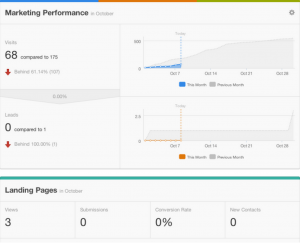What happens if you stop developing content on your web site? What happens to traffic to your business web site?
In a Russian-roulette-style marketing experiment, we’ll see exactly what happened with a client’s case. In August, this client blogged two or three times a week, and traffic rocketed up 129% in a month’s time. In September, we asked the client to hold on blogs for a few weeks, and these are the early October results:

As you can see from the above chart, traffic is way down the first week of October over the first week in September. In fact, traffic has flatlined. Remember, in August we were blogging two to three times per week, creating unique, interesting and informative content around the client’s industry solution.
We should note, the traffic NOW is STILL higher (more than double) what the client was driving to their website from 2010 to 2012 before they began inbound marketing. So even a lack of content this month, their content from previous months still brings them more traffic than two YEARS of conventional marketing did.
Why this experiment? We wanted to see firsthand the immediate effects of content marketing on driving traffic to a business web site. And we wanted to see what would happen when we yanked that content development for what, in business, is a pretty reasonable amount of time: 4 weeks. It’s easy to get off tangent with your marketing content creation for four weeks. Add in a couple of trade shows, more customer work demanding more of your staff’s time – the 4 weeks slipped by nearly unnoticed. Except here, in our inbound metrics, which were so shocking, we immediately queued up blogs for publishing in October.
If you’ve been following our blog, we’ve posted a number of recent posts using actual results from actual client inbound marketing metrics. This halting of content development for 4 weeks is one of the more unique experiments that is really telling of the impact that inbound marketing has on a business web site traffic flow. And how immediate the results are on both sides of this equation – traffic generation and traffic deficit.
The lesson?
- Keep a blogging editorial calendar full of content ideas to feed the pipleline of traffic
- If you know you have a busy time coming up, pre-fill your blog with scheduled posts
- Continual content development is key to keeping traffic, contacts and leads flowing
As we all know, more traffic equals more contacts and more contacts, nurtured, become more leads. More leads become more customers! It’s really a simple formula, when you think about it.
But of course, it’s not just ANY content that works – it’s relevant, informative, quality content based around things your customers (humans) are searching for, questions that your expertise and skill set and product match can answer for them. It’s content matched to specific keyword searches, mapped to keyword research optimized for the maximum number of searches done for that long-tail keyword search string.
The moral of this story? Don’t stop your content marketing plan, even for a week (or four), as it can adversely affect your web site traffic and lead generation efforts in a shockingly short period of time. No slacking!
For a primer on how an inbound content strategy can work for your business, check out the following links:
ALL Spoke8 Links
1. How to increase traffic to your Michigan business web site
2. Getting Results with Inbound Marketing
3. 6 Things to Consider When Shifting to Inbound Marketing
If you want to know more, check out this guide, lead generation lessons from 7,000 businesses. It shows the cumulative effect blogging (content creation) has on traffic on more than 7K businesses’ web sites. That’s a lot of aggregate data that points to more great content = more traffic = more qualified leads. And as we all know, more leads from our web site equals more customers coming in the door!


























